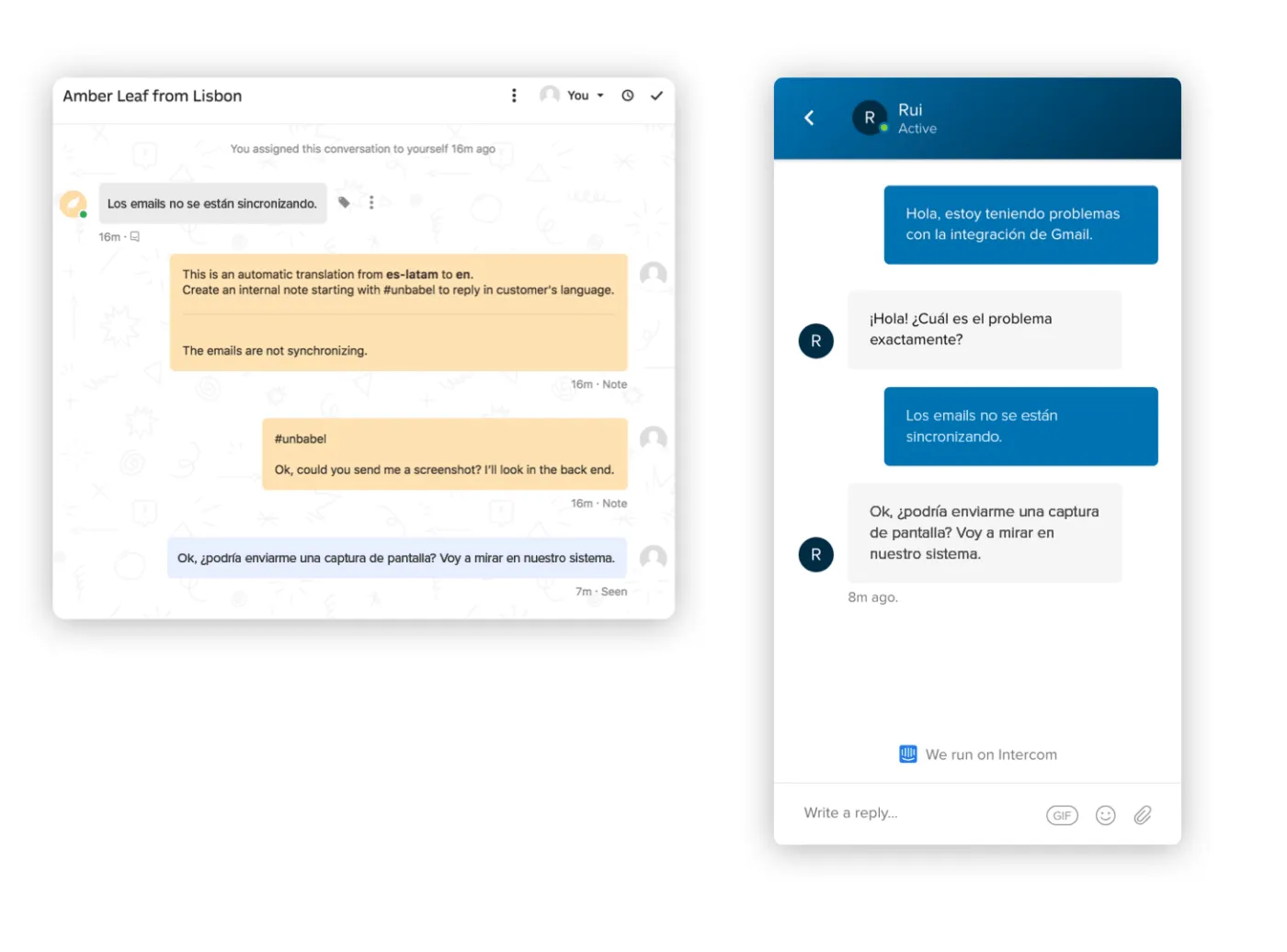
Strategies to take your customer support global
These days, customers expect instant access to support, especially for products that are critical to their business operations. It gives them peace of mind that if something breaks, it can be fixed immediately.
But how do you live up to these expectations if your customers are on one side of the globe?
If your business is expanding internationally, you’ll reach a point in your growth when you’ll need to implement a global support strategy. We spoke with top support leaders to learn how they manage their global support teams. We share their advice for other leaders looking to expand their customer care to more languages and timezones.
The ROI of global customer support
Setting up global customer support requires dedication and investment. In case you’re wondering whether it’s worth the effort, here are some of the key benefits.
- Access to a larger market
Global customer support lets companies more easily communicate with leads and customers in different countries, giving them a competitive edge over other businesses with limited support. - Improved global customer retention
Global support teams can positively influence customer retention, especially if they provide service in their customers’ native language. According to our survey on multilingual customer support, 29% of businesses say they’ve lost customers because they don’t offer multilingual support, while 70% of end users say they feel more loyal to companies that provide support in their native language. - Increased revenue
Customers who receive a positive support experience from a company are 65% more likely to recommend that company to a friend. So excellent global customer support can be a source of revenue. Additionally, returning customers are more likely to purchase from you if their initial experience with your brand – including your support – was positive, which further boosts support ROI. - Consistent customer experience
If people can buy your product in their native language, they should be able to receive support in their native language as well. Multilingual global support teams help to ensure every customer receives the same positive experience, no matter where they live or what language they speak.
Setting up a global customer support team
The benefits of global customer support are clear, but the process of setting up global support operations is undeniably complex. You’ll either need to set up regional teams to provide round-the-clock coverage or look into self-service solutions such as chatbots or a knowledge base to help customers during off-hours. We gathered the following best practices from experienced support leaders to help you get started.
1. Use a “follow the sun” approach
One of the first things that you’ll need to think through is where to locate your team members. You could keep your team members in a single location – but that means team members working odd hours to provide technical support in different time zones. That’s why many support teams opt for locating team members in the same time zones that their customers are in, also known as a “follow the sun” approach.
This approach doesn’t just benefit your customers; it also benefits your team’s work-life balance. Senior Manager of Customer Support and Onboarding at Trakstar (and former Head of Customer Engagement at Recruiterbox) explains:
 |
“Hiring folks remotely allows you to cover 24 hour a day time zones, without anyone working strange hours – just hire in the time zones your customers are living in.” |
2. Work with local recruiters
Recruiting employees in different countries can be a real challenge. How do you know where to look? The online job boards that produce the best candidates are likely to vary from one country to the next: one board that can help you find a strong candidate in the United States likely won’t help you find a similar candidate in New Zealand (let alone Thailand or Hong Kong). Time zone differences, not to mention potential language barriers, can make conducting interviews a challenge.
Zapier’s Vice President of Customer Support Pam Dodrill shares how local recruiter services helped her overcome hiring hurdles:
 |
“Hiring in Asia Pacific was a challenge for us… APAC is a HUGE region with many different cultures and norms within it. Because of that we found that more localized recruiting was needed. For example, a Customer Champion in India could post on local job boards, lending more credibility to a brand not yet well known in India. Same thing in Australia. Having a support manager on the ground to attend job fairs and/or post jobs in local professional groups helped a lot.” |
3. Hire regional team leads
As your support team grows, Pam also advocates for hiring regional team leads to prevent operational issues from going unnoticed:
“When I first started, we did not have a manager in our APAC region. Some of that team reported to different managers in EMEA and/or AMERs West based on time zone. That meant their voice didn’t have a collective ‘voice’ at the managers’ table so things went unnoticed.”
These team leads are critical for ensuring on-the-ground support for team members and keeping leadership apprised of issues that need to be addressed globally.
Running a global customer support team
Once you’ve hired your team, how do you set up operations for round-the-clock support coverage? More importantly, how do you ensure customers are getting a consistent support experience, no matter where they’re located? Support leaders say robust tools, KPIs, and handoff practices are key.
1. Invest in workforce management resources
InVision’s support team uses workforce management software to help them manage schedules and ensure shifts are always covered while giving team members the flexibility to take breaks or adjust hours. InVision’s former Senior Director of Support Sean Kinney explains:
 |
“Once you expand your scope globally, maintaining minimum staffing levels can be prohibitively expensive for a smaller support organization… A scheduling tool is important for coordinating schedules across all regions so that you know that you’ve got the staffing you need around the clock.” |
At Intercom, workforce management falls under the purview of our Support Ops team. Our Senior Director of Customer Support Kaitlin Pettersen explains why we have dedicated team members looking after this area:
 |
“The operational complexities of building and growing a global support team are not small. Building out a workforce management muscle alongside sharp analytics and insights has been huge, as well as working with our teams on the front line to understand what’s working and what’s not.” |
2. Ensure smooth handoffs between regions
Customer support issues don’t conveniently resolve themselves at the end of a shift. So smooth handoffs between regions are critical to maintain a great customer experience. The last thing you want is for customers to have to re-explain their issue just because they’re now working with a different customer support agent on the team.
“Real-time dashboards are essential so that everyone around the world can see and make adjustments dynamically”
Pam Dodrill explains how they use automation at Zapier to share critical info between shifts:
“Real-time dashboards are essential so that everyone around the world can see and make adjustments dynamically. When APAC comes on shift, they should be able to see immediately the same thing the AMER leader is looking at. We also built a ‘handover’ bot that pings our managers’ channel in Slack at each regional shift change to keep everyone looped in at that critical handover time.”
At InVision, dedicated handoff time is built into the team’s schedule to allow ample time for coordination. Sean Kinney explains:
“We use a follow-the-sun approach with staffing in three primary regions: AMER encompassing North and South America; EMEA encompassing Europe, Middle East, and Africa; and APAC, which covers the whole of the Asia-Pacific region. Our goal is to ensure that staff in each region are working a normal first shift schedule for their region/time zones and that each region overlaps to enable smoother handoffs throughout the day.”
Like Zapier, Sean Kinney says InVision also uses Slack for knowledge sharing:
“A modern team chat solution is critical for communicating as a global support team. Without Slack, our staff from region to region would be much more siloed and it wouldn’t be nearly as easy to establish a cohesive, single team. Slack also enables us to push updates to dedicated announcement channels that we can use to help staff more easily catch up on what’s happened while they were offline.”
Here at Intercom, in addition to Slack, we use a shared Inbox to help with coordination on customer issues across shifts. Support members are able to pick up any open customer conversations and leave internal notes for each other to help customers reach faster resolution.

Now some complex issues require in-depth support from a dedicated team and are not always suitable for handoff. Our Director of Customer Support Bobby Stapleton shares how we route complex inquiries that come in at odd hours while minimizing wait time for those customers.
 |
“Customers want help when they need it, even if it means talking to someone across the planet. But for complex, lengthy conversations you need a plan to match them back. We use Intercom attributes to understand where our customers are located and when conversations are created. We then use our Away Mode and Priority Flag features to strategically realign customers with support teams in their region if the conversation requires more follow up. That way, we avoid time zone mismatches that can impact the customer experience and time-to-close on lengthy conversations.” |
3. Establish common KPIs
Support KPIs such as conversations per hour or time to resolution help you monitor your team’s productivity and impact. They’re especially important for distributed teams: by holding team members to similar outcomes across regions, support leaders can be confident that customers are receiving a consistent experience globally. Kaitlin Pettersen shares her perspective on global customer support KPIs:
“Understanding our customers’ experience through CSAT and NPS [net promoter score] is very important to us. We also track and report on productivity metrics like conversations per hour and subsequent response time, but believe there are no perfect metrics. We’re constantly evaluating which metrics contribute to a healthy business and top-notch team and customer experience, so iterating as we learn is a big part of our KPI model.”
Creating a customer experience that scales globally
Salesforce research quantifies the importance of a consistent customer experience: “75% of customers expect consistent experiences across multiple channels (web, mobile, in-person, social), with 73% likely to switch brands if they don’t get it.”
With critical revenue on the line, how do you ensure that crucial consistency when team members are spread across different locations and time zones?
1. Create shared values while respecting cultural differences
It’s important that your whole team is invested in the same company and team values. Whether it’s sharing feedback, taking ownership of issues, or passionate customer focus, shared values will keep your teams aligned regardless of regional differences. Bobby Stapleton emphasizes this point:
“Values and culture are often viewed as a ‘nice to have’ since they don’t tie directly to a metric. But having shared values and a shared global mission creates essential cohesion for your business and customer experience.”
At the same time, it’s equally important to give team members latitude to tailor their support for the local market. Customer support guidelines should empower team members to offer support that’s culturally appropriate and personable. At Recruiterbox, Chelsea Baker instilled this respect for cultural differences through rigorous training:
“[Supporting customers globally requires an] understanding of the cultures you’re working with and training for your team to make sure they’re being mindful of how different cultures process information or communicate.”
Frame.io’s Director of Customer Experience Brett Rush shares in greater detail how his team remains culturally mindful when responding to customer inquiries spanning 180 countries:
 |
“When answering customers in other countries, our team considers cultural differences and using an active voice. In the US, we can use emojis or slang and customers generally enjoy the conversation. In other countries, Customer Support should remain professional to ensure we don’t offend anyone. Also, we shouldn’t ever say, ‘the problem you’re having’ directing that it’s their problem. This doesn’t translate well. Separate the person from the experience.” |
Supporting a customer when they feel confused or frustrated takes finesse. Being mindful of cultural differences will ensure your customers feel supported and understood.
2. Rigorously communicate internal processes
When support teams are distributed, it can be challenging to ensure all team members receive the same training and information. Sean Kinney explains this issue well:
“Processes that are shared verbally/informally or which rely on an individual’s own heroic effort don’t work well when scaled to a global level. You can very quickly see that each region begins to handle requests a little differently, which creates a fragmented, inconsistent support experience.”
At Intercom, we use tools like Guru to document all internal processes and make it easy for team members to access that information globally. Our R&D Operations Manager (and former Senior Enablement Specialist) Juci Kulloi shares how our Enablement team reinforces this knowledge sharing:
 |
“There is a Slack channel dedicated to daily handover information threads. We also create a standard deck with key updates for CS managers to share at their biweekly team meetings. For larger product releases, we create emails, Workramp trainings, and walkthrough videos that get shared through our weekly CS newsletter. This newsletter also summarizes everything that happened in the last week and what’s coming up. Starting early next year, we are also introducing monthly live trainings for the team.” |
3. Leverage multilingual support tools
The dream of every support team is to offer perfect assistance in all the languages their customers speak, and all the time zones they’re in. But in reality, very few companies have the budget or staffing capabilities to create that kind of experience.
Luckily, real-time translation tools such as Unbabel and Lokalise can help you quickly translate customer messages and conversations in nearly every language imaginable. And if you’re using Intercom, you can integrate these tools with the Inbox and use them to not just translate inbound conversations but also reply to customers in their native language.

Localizing content served through self-service support tools like help centers and chatbots is also a great way to help customers find answers no matter when they’re seeking help or what language they’re speaking.
Multilingual tools become even more essential when you consider the finding that 35% of end users would be willing to switch products just to get support in their native tongue.
4. Set expectations, underpromise and overdeliver
Our EMEA Senior Manager of Customer Support Ruth O’Brien has this final piece of advice for support teams with limited resources. At the end of the day, customers simply want to know when to expect a response to their queries. So be transparent when your team is online and how quickly they typically reply to new conversations. If you run a skeleton crew on certain days of the week or times of day or regions, have your team be honest with customers about that so they understand if responses are slower.
 |
“When you tell customers you’ll reply within an hour and they wait four hours, it chips away at their trust in your support and in turn your company’s brand. Never make promises you can’t keep. When you overdeliver on the expectations you set it results in customer delight, brand trust and ultimately retention/expansion.” |
Drive customer success with global support
As your business goes global, it’s important to not let your support strategy fall behind. After all, customer retention and satisfaction are paramount to the ongoing health of your business. Use the advice from top support leaders to build a world-class global customer support team that meets customers’ expectations for real-time support.







